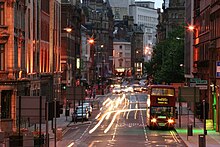Victoria Street, Liverpool
 Victoria Street, 2008 | |
| Location | Liverpool city centre |
|---|---|
| Postal code | L2 |
| Coordinates | 53°24′30″N 2°59′11″W / 53.4082°N 2.9863°W |
| Other | |
| Known for |
|
Victoria Street is a road in Liverpool, England. Situated in the city centre, it runs between the Queensway Tunnel entrance to Cook Street.
History
[edit]Dating back to the 1860s, the street's offices and commercial buildings meant that it played a key part during the growth of Liverpool.[1] During the 19th century, the street became home to fruit and produce dealers, warehouses, offices and banks, aided by its proximity to the docks and Liverpool Exchange railway station.[2]
At one point, three railway companies had depots on the street. The Midland Railway built a depot on the corner where Victoria Street meets Crosshall Street in 1872.[3] Designed by local architect Henry Sumners of Culshaw and Sumners, the building was later extended towards Peter Street in 1878. In the mid-1990s the building was converted into a convervation centre for National Museums Liverpool, known as the National Conservation Centre.[4] The Fruit Exchange Building was built c.1888 in as a rail depot before being converted into a fruit exchange in 1923.[5] During its heyday, hundreds of people would attend auctions to purchase fruit that had been shipped into Liverpool from around the world.[6] Adjacent to it, the Produce Exchange Buildings was built in 1902 as a produce warehouse for the Lancashire and Yorkshire Railway before being converted into offices.[7]
Liverpool's main post office opened on Victoria Street in 1899, having previously been in Custom House at Canning Dock.[8] The building was damaged during the May 1941 blitz and had the upper floors removed.[9] The post office moved to another location during the 20th century and after being derlict for a while the building was converted into a shopping centre called the Metquarter.
Renowned Liverpool nightclub, Eric's Club opened on Victoria Street in 1976 before later moving to Mathew Street.[10] During its four-year lifespan it hosted local bands such as Dead or Alive, Echo & the Bunnymen and Orchestral Manoeuvres in the Dark as well as international acts like U2, Talking Heads and The Ramones.
Listed buildings
[edit]Victoria Street contains ten listed buildings.[11] These include:
References
[edit]- ^ "Victoria Street: Victorian with a vengeance – Liverpool History Society". Retrieved 27 May 2024.
- ^ "Looking at Buildings: Victoria Street". www.lookingatbuildings.org.uk. Retrieved 27 May 2024.
- ^ Sharples, Joseph (2012), "William Culshaw (1807–74) and Henry Sumners (1825–95): rebuilding Victorian Liverpool", in Webster, Christopher (ed.), The Practice of Architecture: eight architects, 1830–1930, Spire Studies in Architectural History, vol. 2, Reading: Spire Books, p. 67, ISBN 978-1-904965-35-0
- ^ Pye, Ken (2011), Discover Liverpool, Liverpool: Trinity Mirror Media, p. 89, ISBN 978-1-906802-90-5
- ^ Historic England. "FRUIT EXCHANGE (1392539)". National Heritage List for England. Retrieved 27 May 2024.
- ^ Shennan, Paddy (13 April 2016). "Look inside Liverpool Fruit Exchange to find out why it should be saved". Liverpool Echo. Retrieved 27 May 2024.
- ^ "Produce Exchange Buildings, Central, Liverpool". britishlistedbuildings.co.uk. Retrieved 27 May 2024.
- ^ "Liverpool Post Office (1899)". British Post Office Buildings and Their Architects : an Illustrated Guide. Retrieved 27 May 2024.
- ^ "Looking at Buildings: General Post Office". www.lookingatbuildings.org.uk. Retrieved 27 May 2024.
- ^ Molyneux, Jess; Bona, Emilia (4 April 2020). "88 beloved bars and nightclubs we have lost down the years". Liverpool Echo. Retrieved 27 May 2024.
- ^ "Listed Buildings in Liverpool • Historic Liverpool". Historic Liverpool. 25 April 2012. Retrieved 27 May 2024.

